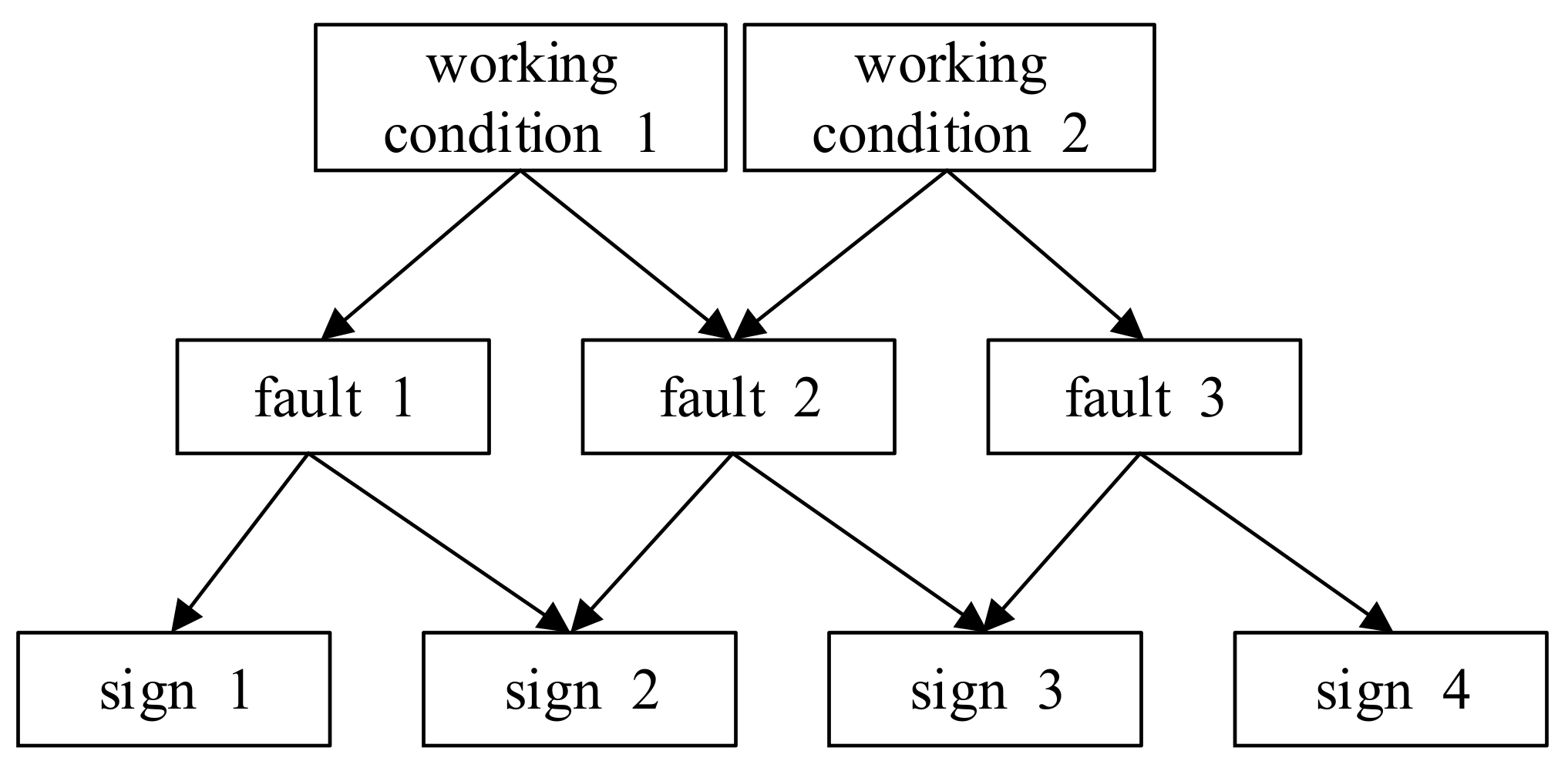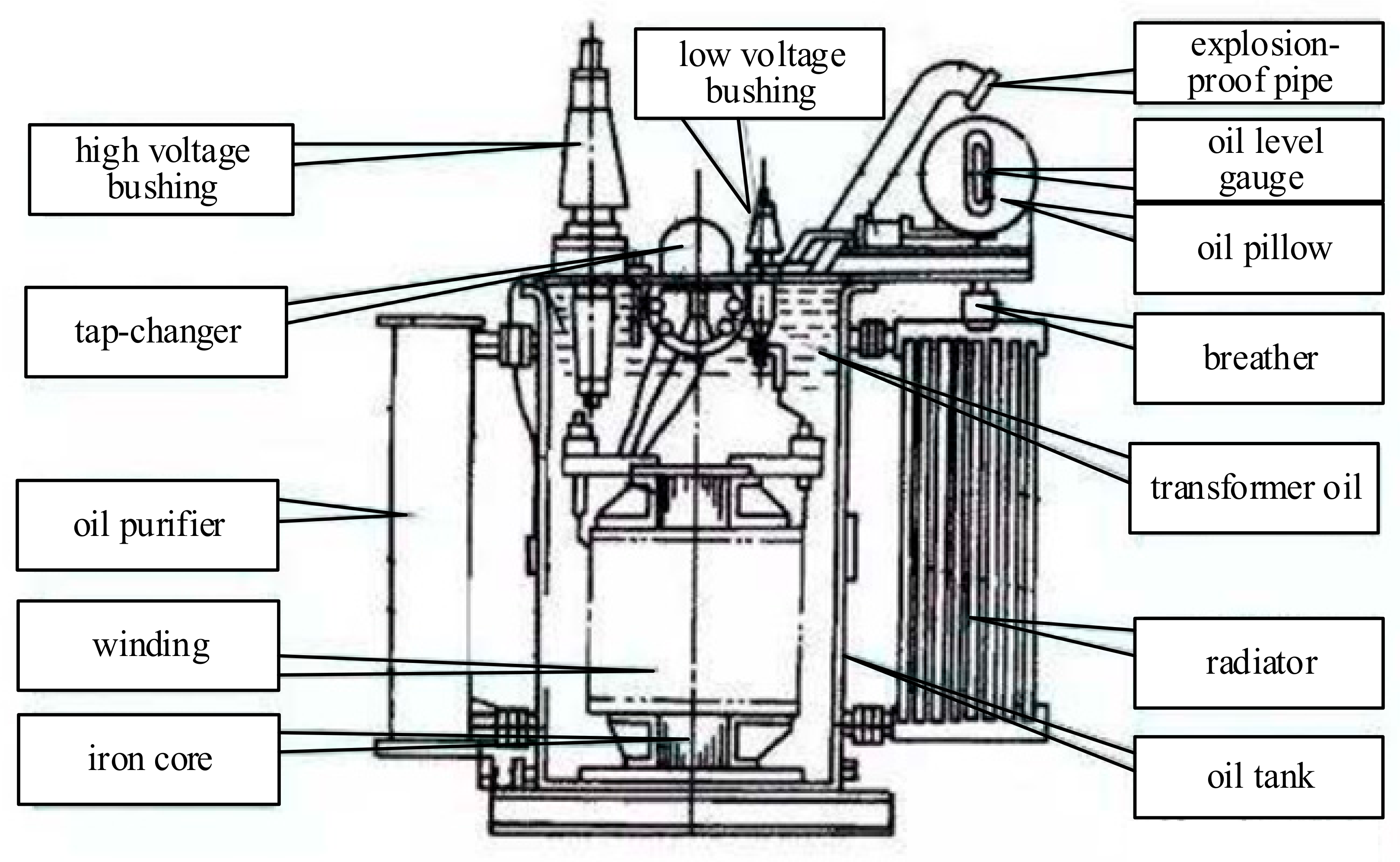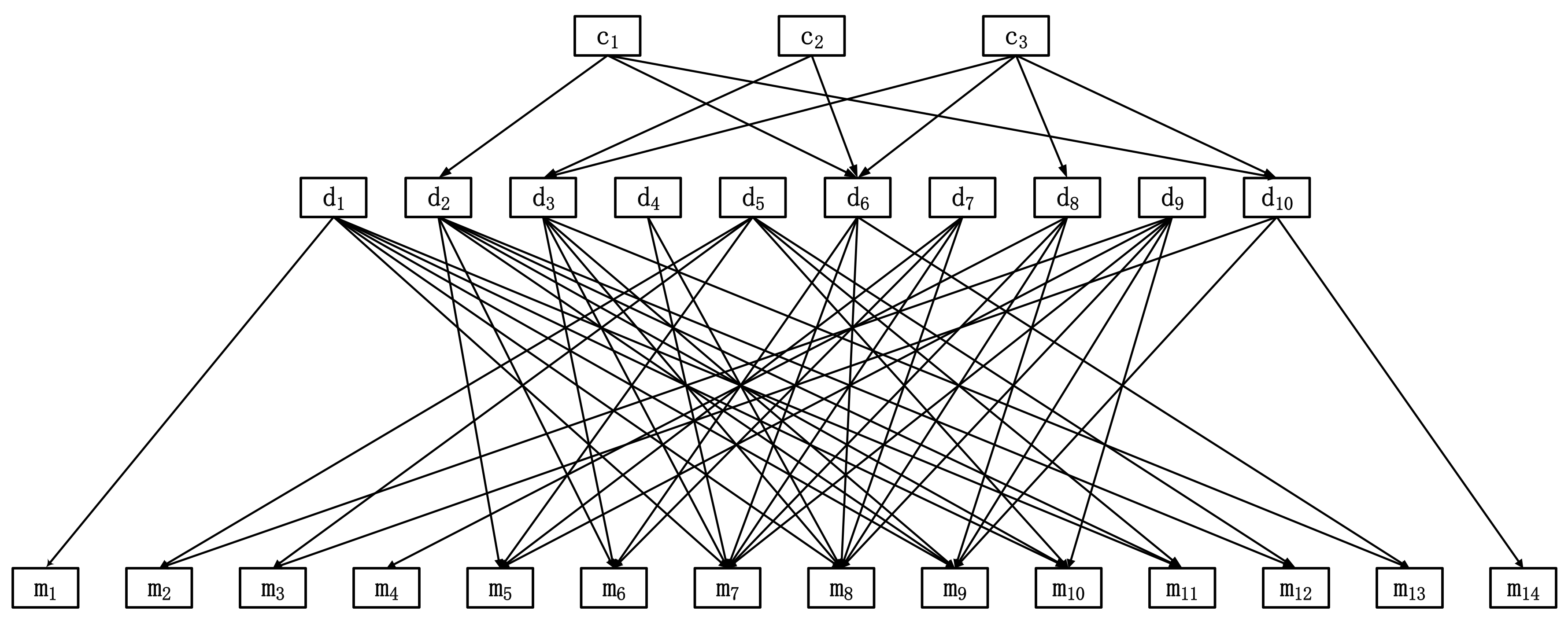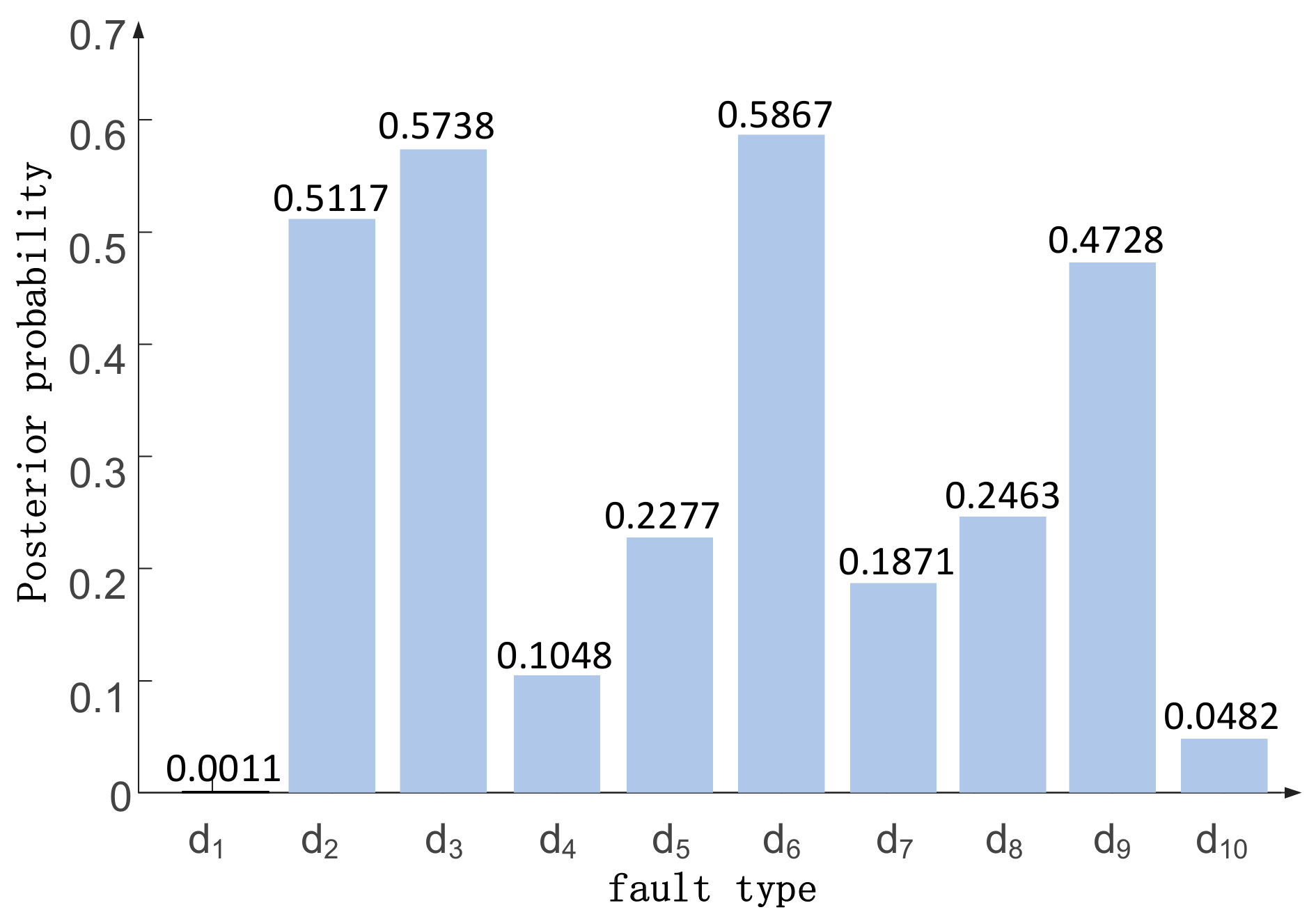RETRACTED: Fault Diagnosis of Traction Transformer Based on Bayesian Network
Abstract
1. Introduction
- Considering the imbalance, impact, and nonlinear characteristics of traction load [28], this paper established the operation condition layer and sign layer of a Bayesian diagnostic network. Through the statistical analysis of historical data, the prior probability of each working condition is calculated, and the adverse operation conditions are correlated with fault types by analyzing the failure mechanism. In addition, abnormal symptoms, which occurred frequently in the traction transformer, are added to comprehensively analyze the operation state of the traction transformer from the perspective of both working conditions and symptoms.
- The association rule method is proposed to analyze the correlation degree between the failure of the traction transformer and the abnormal symptoms. By combining the field data, the support degree between abnormal symptoms and fault types is calculated to determine whether there is a corresponding relationship between the fault types and abnormal symptoms. Then, the confidence level is calculated to determine the causal condition probability. The parameters of the Bayesian network are set according to the calculated conditional probability to make the parameters more objective and the diagnosed results more accurate.
2. Association Rules and Bayesian Network Theory
2.1. Association Rules
2.2. Bayesian Networks
2.3. Probabilistic Inference of Bayesian Networks
2.4. Bayesian Network Association Tree Algorithm
2.5. Establishment of Fault Diagnosis Model of Bayesian Network
2.5.1. Association Rules of Calculating the Degree of Association
2.5.2. Establishment of the Bayesian Diagnostic Network
2.5.3. Acquisition of Conditional Probability of the Bayesian Network
2.5.4. Bayesian Network Reasoning
3. Example of Traction Transformer Diagnosis
3.1. Example Introduction
3.2. Test Data
3.3. Fault diagnosis of the Bayesian Network
3.4. Result Analysis
4. Conclusions
Author Contributions
Funding
Conflicts of Interest
References
- Sun, X.J.; Lin, S.; Feng, D.; HE, Z. Short-term risk assessment of traction transformer considering load characteristics. Power Grid Technol. 2016, 40, 2817–2823. [Google Scholar]
- Lin, S.; Chen, X.; Wang, Q. Fault diagnosis model based on Bayesian network considering information uncertainty and its application in traction power supply system. IEEJ Trans. Electr. Electr. Eng. 2018, 13, 671–680. [Google Scholar] [CrossRef]
- Chen, S.; Qi, Z.; Chen, D.; Guo, L.; Peng, W. Investigation of Bayesian network for reliability analysis and fault diagnosis of complex systems with real case applications. Adv. Mech. Eng. 2017, 9, 1687814017728853. [Google Scholar] [CrossRef]
- Wu, Y.; Jiang, B.; Lu, N.; Zhou, Y. Bayesian network based fault prognosis via bond graph modeling of high-speed railway traction device. Math. Probl. Eng. 2015. [Google Scholar] [CrossRef]
- Cong, G.; Xu, W.; Xing, Z. Reliability Analysis of Metro Traction Substation Based on Bayesian Network. In Proceedings of the International Conference on Electrical and Information Technologies for Rail Transportation, Qingdao, China, 25–27 October 2019; Springer: Singapore, 2019; pp. 439–449. [Google Scholar]
- Zhang, W.; Yuan, J.; Wang, S.; Zhang, K. Calculation method of transformer fault basic reliability distribution based on improved three-ratio method. Power Syst. Prot. Control 2015, 43, 115–121. [Google Scholar]
- Li, Y.; Shu, N. Transformer Fault Diagnosis Based on Fuzzy Clustering and Complete Binary Tree Support Vector Machine. Trans. China Electrotech. Soc. 2016, 31, 64–70. [Google Scholar]
- Benmahamed, Y.; Teguar, M.; Boubakeur, A. Application of SVM and KNN to Duval Pentagon 1 for transformer oil diagnosis. IEEE Trans. Dielectr. Electr. Insul. 2017, 24, 3443–3451. [Google Scholar] [CrossRef]
- Tao, X.; Li, Z.; Liu, F.; Zhang, Y. Transformer fault detection method based on reduced set support vector machine. High. Volt. Technol. 2016, 42, 3199–3206. [Google Scholar]
- Shintemirov, A.; Tang, W.; Wu, Q.H. Power Transformer Fault Classification Based on Dissolved Gas Analysis by Implementing Bootstrap and Genetic Programming. IEEE Trans. Syst. Man Cybern. Part C Appl. Rev. 2009, 39, 69–79. [Google Scholar] [CrossRef]
- Su, H.; Dong, H. Transformer fault diagnosis based on reasoning integration of rough set and fuzzy set and Bayesian optimal classifier. Wseas Trans. Circuits Syst. 2009, 8, 136–145. [Google Scholar]
- Zhang, Y.; Ding, X.; Liu, Y.; Griffin, P.J. An artificial neural network approach to transformer fault diagnosis. IEEE Trans. Power Deliv. 2002, 11, 1836–1841. [Google Scholar] [CrossRef]
- Yu, X.; Zang, H. Transformer fault diagnosis based on rough sets theory and artificial neural networks. In Proceedings of the International Conference on Condition Monitoring & Diagnosis, Beijing, China, 21–24 April 2008; pp. 1342–1345. [Google Scholar]
- Zhang, D.B.; Xu, Y.; Wang, Y.N. Application of active differential11 learning neural network integration method in transformer DGA fault diagnosis. Chin. J. Electr. Eng. 2010, 30, 64–70. [Google Scholar]
- Liao, R.J.; Liao, Y.X.; Yang, L.J.; Wang, Y.Y. Study on synthetic diagnosis method of transformer fault using multi-neural network and evidence theory. Proc. CSEE 2006, 26, 119–124. [Google Scholar]
- Ruijin, L.I.A.O.; Fanjin, M.E.N.G.; Nianrong, Z.H.O. UAssessment Strategy for Inner Insulation Condition of Power Transformer Based on set-pair Analysis and Evidential Reasoning decision-making Based on integration of Set pair Analysis and evidence theory. High. Volt. Technol. 2014, 40, 474–481. [Google Scholar]
- Shi, X.; Zhu, Y.; Ning, X.; Wang, L.; Sun, G.; Chen, G. Fault diagnosis of power transformers based on deep self-coding network. Power Autom. Equip. 2016, 36, 122–126. [Google Scholar]
- Dai, J.; Song, H.; Sheng, G.; Jiang, X. Dissolved gas analysis of insulating oil for power transformer fault diagnosis with deep belief network. IEEE Trans. Dielectr. Electr. Insul. 2017, 24, 2828–2835. [Google Scholar] [CrossRef]
- Zou, A.; Deng, R.; Mei, Q.; Zou, L. Fault diagnosis of a transformer based on polynomial neural networks. Clust. Comput. 2017, 22, 1–9. [Google Scholar] [CrossRef]
- Zheng, Y.B.; Sun, C.X.; Li, J.; Chen, W.G.; Wang, Y.Y. Association rule analysis of transformer fault characteristic quantity reliability. High. Volt. Technol. 2012, 38, 87–93. [Google Scholar]
- Nie, Y. Research on Transformer Fault Diagnosis Method Based on Bayesian Network. Master’s Thesis, North China Electric Power University, Baoding, China, 2007. [Google Scholar]
- Bai, C.F.; Gao, W.; Jin, L.; Yu, W.; Zhu, W. Transformer integrated fault diagnosis based on three-layer Bayesian network. High. Volt. Technol. 2013, 39, 330–335. [Google Scholar]
- Wang, Y.Q.; Lu, F.C.; Li, H.M. Fault diagnosis of power transformers based on rough set theory and Bayesian network. Chin. J. Electr. Eng. 2006, 08, 137–141. [Google Scholar]
- Chen, X. Research on Transformer Fault Diagnosis Method Based on Rough Set Theory and Bayesian Network. Master’s Thesis, Shandong University, Jinan, China, 2018. [Google Scholar]
- Xie, Q.J.; Zeng, H.X.; Ruan, L.; Chen, X.M.; Zhang, H.L. Transformer fault diagnosis based on Bayesian network and rough set reduction theory. In Proceedings of the TENCON Spring Conference, Sydney, Australia, 17–19 April 2013; pp. 262–266. [Google Scholar]
- Xiao, G. Fault Diagnosis Method of Power Transformer Based on Immune Algorithm—Rough Set—Bayesian Network. Master’s Thesis, Xiangtan University, Xiangtan, China, 2009. [Google Scholar]
- Zhang, Z.Y.; Lin, Z.F.; Liu, D.; Huang, J.L. Transformer fault diagnosis based on normal cloud model and improved Bayesian classifier. Electr. Meas. Instrum. 2017, 54, 50–56. (In Chinese) [Google Scholar]
- Feng, D.; Lin, S.; Sun, X.; He, Z. Reliability assessment of traction transformer considering load characteristics of high-speed railway. J. China Railw. 2017, 39, 62–69. [Google Scholar]
- State Grid Corporation of China. Guidelines for State Evaluation of Oil-Immersed Transformers (Reactors); Electric Power Press: Beijing, China, 2008. [Google Scholar]
- Xie, L.J.; Li, L.; Cheng, Y.; Lu, M.; Jiang, L.Q.; Teng, Y. Transformer fault diagnosis method based on fusion set pair analysis and association rules. Chin. J. Electr. Eng. 2015, 35, 277–286. [Google Scholar]




| Poor working Conditions | Overload | Exports of Short Circuit | The Invasion of Wave |
|---|---|---|---|
| Probability value | 0.09 | 0.08 | 0.01 |
| Number | Fault Types | Number | Fault Types |
|---|---|---|---|
| d1 | Iron core multi-point grounding | d6 | Turn insulation damage, Short circuit |
| d2 | Insulation aging | d7 | Screen discharge |
| d3 | Winding deformation | d8 | Magnetic flux leakage heating Magnetic shield discharge overheating |
| d4 | Suspended discharge | d9 | Discharge in oil |
| d5 | Damp insulation | d10 | Tap changer Lead failure |
| Number | Test Items | Number | Test Items |
|---|---|---|---|
| m1 | Core Ground Current | m8 | Partial discharge |
| m2 | Leakage current | m9 | Overheated of Three ratio |
| m3 | Winding absorption ratio and polarization index | m10 | Strength of insulating oil and gas |
| m4 | Power frequency withstand voltage | m11 | Insulation resistance |
| m5 | Water content in oil | m12 | Dielectric loss tangent |
| m6 | m13 | Winding ratio error | |
| m7 | Discharge of Three ratio | m14 | Three phase unbalance coefficient of winding DC resistance |
| d5 | m10 | m11 | m12 | m14 |
|---|---|---|---|---|
| 1 | 1 | 1 | 1 | 1 |
| 1 | 1 | 1 | 1 | 1 |
| 1 | 1 | 0 | 1 | 0 |
| 1 | 1 | 1 | 1 | 1 |
| 1 | 0 | 1 | 1 | 1 |
| 1 | 1 | 1 | 1 | 0 |
| … | … | … | … | … |
| Failure Mode (Cause) | Abnormal Symptoms (Results) |
|---|---|
| Iron core multi-point grounding d1 | Strength of insulating oil and gas m10 |
| insulation resistance m11 | |
| Insulation aging d2 | insulation resistance m11 |
| dielectric loss tangent m12 | |
| Damp insulation d5 | Leakage current m2 |
| Oil and gas strength m10 | |
| insulation resistance m11 | |
| Dielectric loss tangent m12 | |
| Magnetic flux leakage heating Magnetic shield discharge overheating d8 | Power frequency withstand voltage m4 |
| Discharge in oil d9 | Leakage current m2 |
| Strength of insulating oil and gas m10 |
| Node Information | Conditional Probability | |
|---|---|---|
| Poor working conditions (c) | overload (c1) | P (c1) = 0.09 |
| The invasion of wave (c2) | P (c2) = 0.01 | |
| Exports of short circuit(c3) | P (c3) = 0.08 | |
| fault type (d) | Iron core multi-point grounding (d1) | P (d1) = 0.2271 |
| Insulation aging (d2) | Pc1 = 0.6; PL = 0.5 | |
| Winding deformation (d3) | Pc3 = 0.6; Pc2 = 0.6; PL = 0.5 | |
| Suspended discharge (d4) | P(d4) = 0.0798 | |
| Damp insulation (d5) | P(d5) = 0.0506 | |
| Turn insulation damage and turn to turn short circuit (d6) | Pc1 = 0.6; Pc3 = 0.6; Pc2 = 0.6; PL = 0.5 | |
| Screen discharge (d7) | P (d7) = 0.1421 | |
| Magnetic flux leakage heating Magnetic shield discharge overheating (d8) | Pc3 = 0.6; PL = 0.5 | |
| Discharge in oil (d9) | P(d9) = 0.0717 | |
| Tap changer and lead failure (d10) | Pc1 = 0.6; Pc3 = 0.6; PL = 0.5 | |
| fault symptoms (m) | Core Ground Current (m1) | Pd1 = 0.90; PL = 0.01 |
| Leakage current (m2) | Pd5 = 0.56; Pd9 = 0.716; PL = 0.01 | |
| Winding absorption ratio and polarization index (m3) | Pd5 = 0.75; PL = 0.01 | |
| Power frequency withstand voltage (m4) | Pd8 = 0.82; PL = 0.01 | |
| Water content in oil (m5) | Pd2 = 0.267; Pd5 = 0.718; Pd7 = 0.416; Pd9 = 0.60 PL = 0.01 | |
| (m6) | Pd2 = 0.816; Pd6 = 0.681; Pd7 = 0.759; Pd3=0.721 PL = 0.01 | |
| Discharge of Three ratio (m7) | Pd1 = 0.189; Pd8 = 0.289; Pd6 = 0.515; Pd10 = 0.231 Pd4 = 0.863; Pd7 = 0.879; Pd3 = 0.681; Pd9 = 0.70 PL = 0.01 | |
| partial discharge (m8) | Pd1 = 0.30; Pd8 = 0.35; Pd6 = 0.90; Pd4 = 0.90 Pd7 = 0.90; Pd3 = 0.75; Pd9 = 0.90; PL = 0.01 | |
| overheated of Three ratio (m9) | Pd1 = 0.818; Pd2 = 0.219; Pd8 = 0.713; Pd10 = 0.674 Pd3 = 0.149; Pd9 = 0.20; PL = 0.01 | |
| Strength of insulating oil and gas (m10) | Pd2 = 0.887; Pd9 = 0.758; PL=0.01 | |
| insulation resistance (m11) | Pd1 = 0.85; Pd2 = 0.87; PL=0.01 | |
| Dielectric loss tangent (m12) | Pd2 = 0.754; Pd5 = 0.808; PL=0.01 | |
| Winding ratio error (m13) | Pd6 = 0.80; Pd3 = 0.80; PL = 0.01 | |
| Three phase unbalance coefficient of winding DC resistance (m14) | Pd10 = 0.87; PL = 0.01 | |
| High Pressure Side | Low Pressure Side | ||
|---|---|---|---|
| Tap changer | Ⅲ | Phase separation | |
| AO | 1.1870 | ab | 0.1188 |
| BO | 1.1890 | bc | 0.1196 |
| CO | 1.1940 | ca | 0.1195 |
| average | 1.1900 | average | 0.1190 |
| error (%) | 0.5900 | error | 0.67 |
| H2 | CH4 | C2H6 | C2H4 | C2H2 | |
|---|---|---|---|---|---|
| Content (ppm) | 150 | 44.2 | 16.2 | 47 | 8.5 |
| 15 s | 60 s | Absorption Ratio | |
|---|---|---|---|
| High- low/ground | 4.540 | 7.250 | 1.59 |
| Low- high/ground | 3.360 | 5.250 | 1.56 |
| Core insulation | // | 0.014 | // |
| Breakdown Times | 1 | 2 | 3 | 4 | Average |
|---|---|---|---|---|---|
| breakdown voltage(kV) | 54.4 | 53.6 | 77.1 | 43.5 | 57.15 |
| Test Voltage (kV) | Dielectric Loss tg (%) | Capacitance (nF) | |
|---|---|---|---|
| High-low/ground | 10 | 10.92 | 7.342 |
| Low-high/ground | 10 | 0.81 | 9.782 |
| Test Voltage (μA) | Leakage Current (μA) | |
|---|---|---|
| High-low/ground | 40 | 150 |
| Low-high/ground | 20 | 5 |
© 2020 by the authors. Licensee MDPI, Basel, Switzerland. This article is an open access article distributed under the terms and conditions of the Creative Commons Attribution (CC BY) license (http://creativecommons.org/licenses/by/4.0/).
Share and Cite
Xiao, Y.; Pan, W.; Guo, X.; Bi, S.; Feng, D.; Lin, S. RETRACTED: Fault Diagnosis of Traction Transformer Based on Bayesian Network. Energies 2020, 13, 4966. https://doi.org/10.3390/en13184966
Xiao Y, Pan W, Guo X, Bi S, Feng D, Lin S. RETRACTED: Fault Diagnosis of Traction Transformer Based on Bayesian Network. Energies. 2020; 13(18):4966. https://doi.org/10.3390/en13184966
Chicago/Turabian StyleXiao, Yong, Weiguo Pan, Xiaomin Guo, Sheng Bi, Ding Feng, and Sheng Lin. 2020. "RETRACTED: Fault Diagnosis of Traction Transformer Based on Bayesian Network" Energies 13, no. 18: 4966. https://doi.org/10.3390/en13184966
APA StyleXiao, Y., Pan, W., Guo, X., Bi, S., Feng, D., & Lin, S. (2020). RETRACTED: Fault Diagnosis of Traction Transformer Based on Bayesian Network. Energies, 13(18), 4966. https://doi.org/10.3390/en13184966





